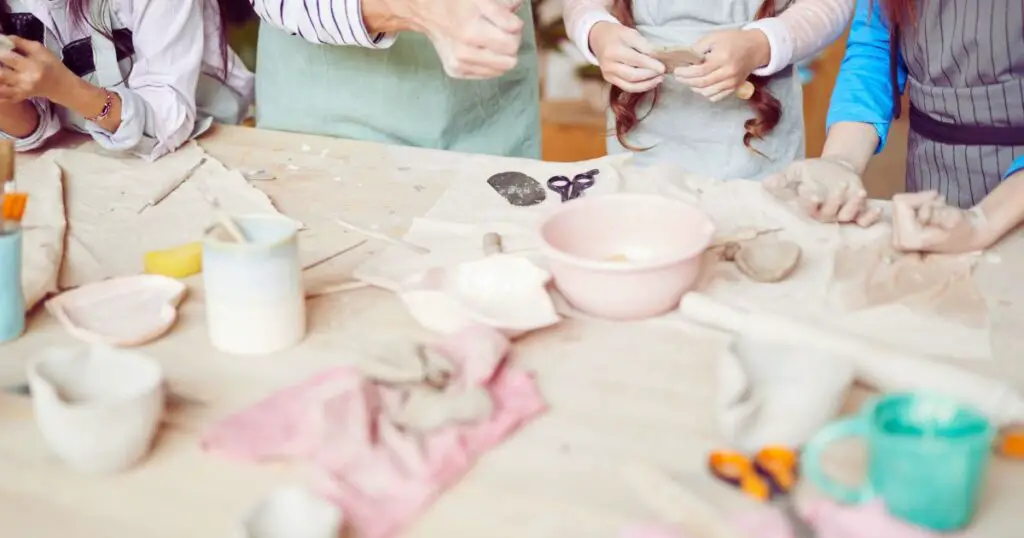As an Amazon affiliate, I may earn from qualifying purchases. Please read our Disclaimer and Privacy Policy.
Are you looking for pottery studio supplies to start your own business, or are they for your own personal use?
The pottery studio supplies mentioned in this post are primarily for people who want to set up their own studio. However, you could use the list as a starting point to eventually setting up a business.
While there is significant overlap between the supplies needed for a personal pottery studio and a business-oriented pottery studio, the scale, scope, and specific needs differ between the two.
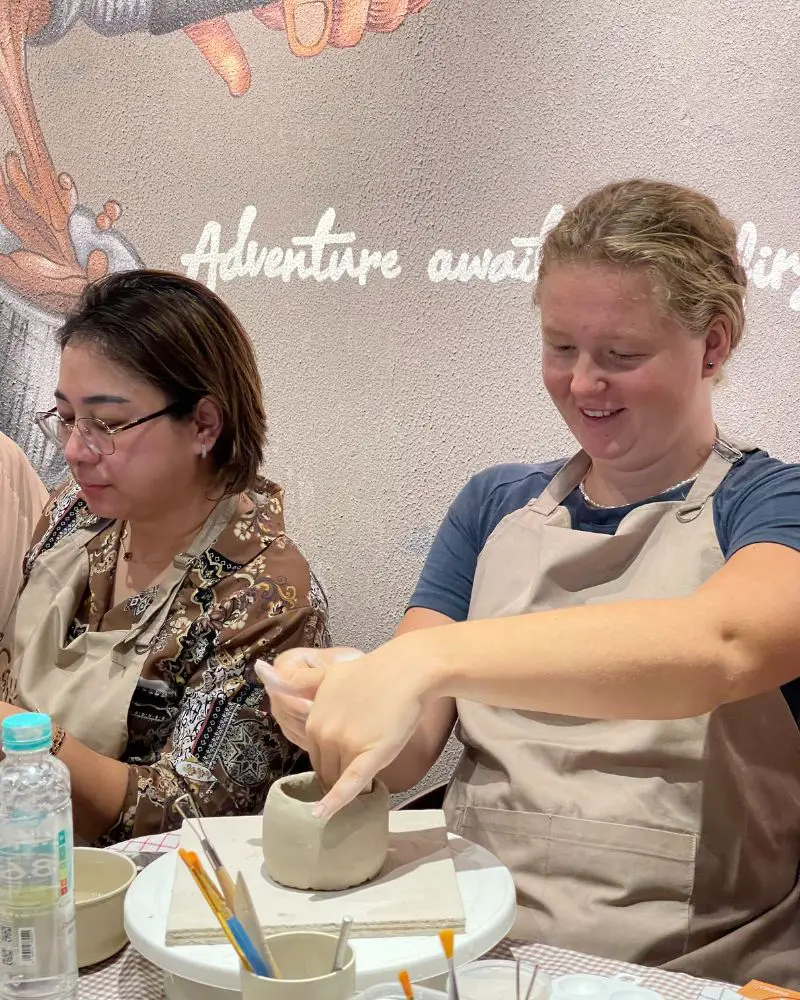
The Growing Popularity of Pottery Making
If you’re into making pottery, you probably already know the benefits of this type of creative expression.
Creating functional and artistic pieces for your own personal use is very satisfying. It’s fun and it’s messy!
When you live in a world where everything is mass produced, it’s nice to be able to create something that came from your own imagination and style.
Therapeutic Benefits
Shaping and molding clay can be a meditative experience. It’s relaxing way to reduce stress and promote mental well-being. Sure, you might get a little frustrated if you’re pottery isn’t turning out the way you planned.
But that’s okay! Just enjoy the process and allow the experience to melt your stress away.
Creative Expression
Whether you’re wheel throwing to create functional or sculpural pieces, or hand building where you mold the clay using your fingers, you’re free to create whatever you want.
There’s no right or wrong when playing for creative expression.
Desire for Handmade and Sustainable Goods
Pottery provides a sustainable alternative to factory-made goods. The uniqueness of each hand-crafted piece is appreciated in today’s mass produced world.
Socialization
Even though a lot of people are discovering pottery through social media, the actual process of pottery-making often happens in group settings.
It’s a great way to step way from your phone and into a world where artistic expression is appreciated. If you’re an introvert like me, it helps get you out of the house and into social settings.
It’s especially great for people over 50 who are retired and looking to make new friends. Actually, I wrote a post about how to make new friends through hobbies. You can read it at: 5 Easy Ways to Foster New Friendships Over 50
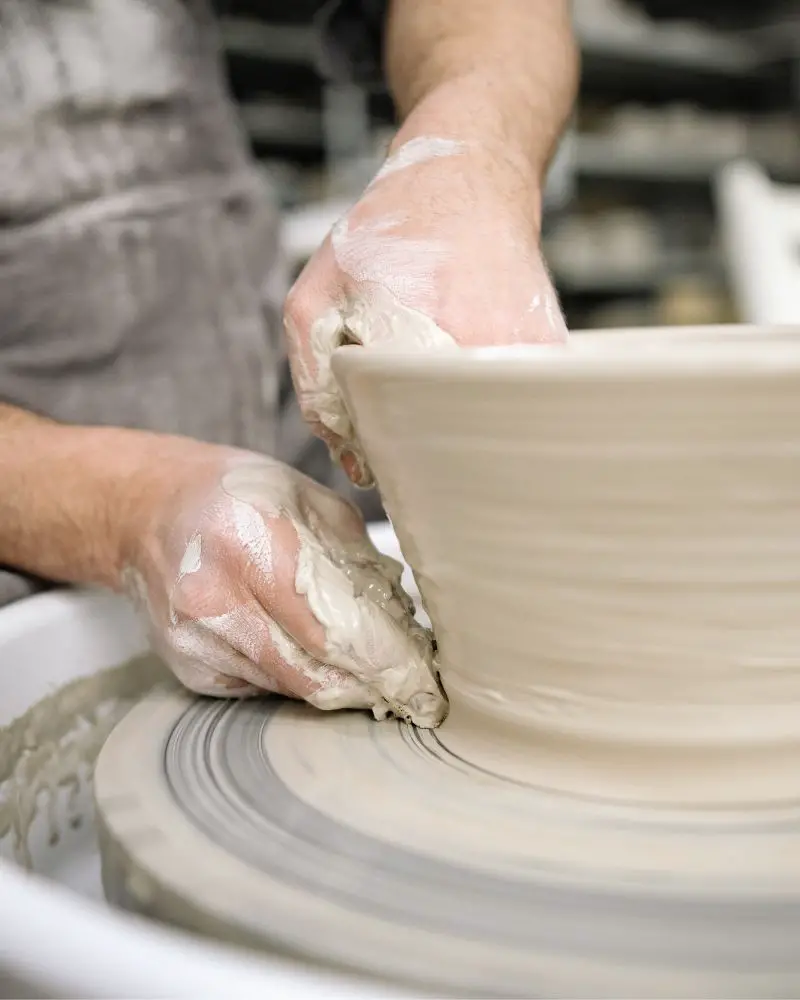
Pottery Studio Supplies: Business vs Personal Use
There are several similarities and differences between personal and business studios in terms of the supplies needed.
Both types of studios require essential equipment such as pottery wheels (electric or kick-style), kilns, a variety of clay and pottery tools like needle tools, metal ribs, and wire clay cutters.
Both setups also need work tables for hand-building and glazing, as well as shelving to store materials and finished pieces.
The key differences, however, come down to scale and specialization.
Naturally, business studios need more equipment and higher quantities.
For example, you’ll need multiple pottery wheels, larger electric kilns, pug mills, and slab rollers to accommodate higher production or group classes.
Unless you want to sell your work or teach classes, you probably won’t need the same volume of equipment in a personal studio.
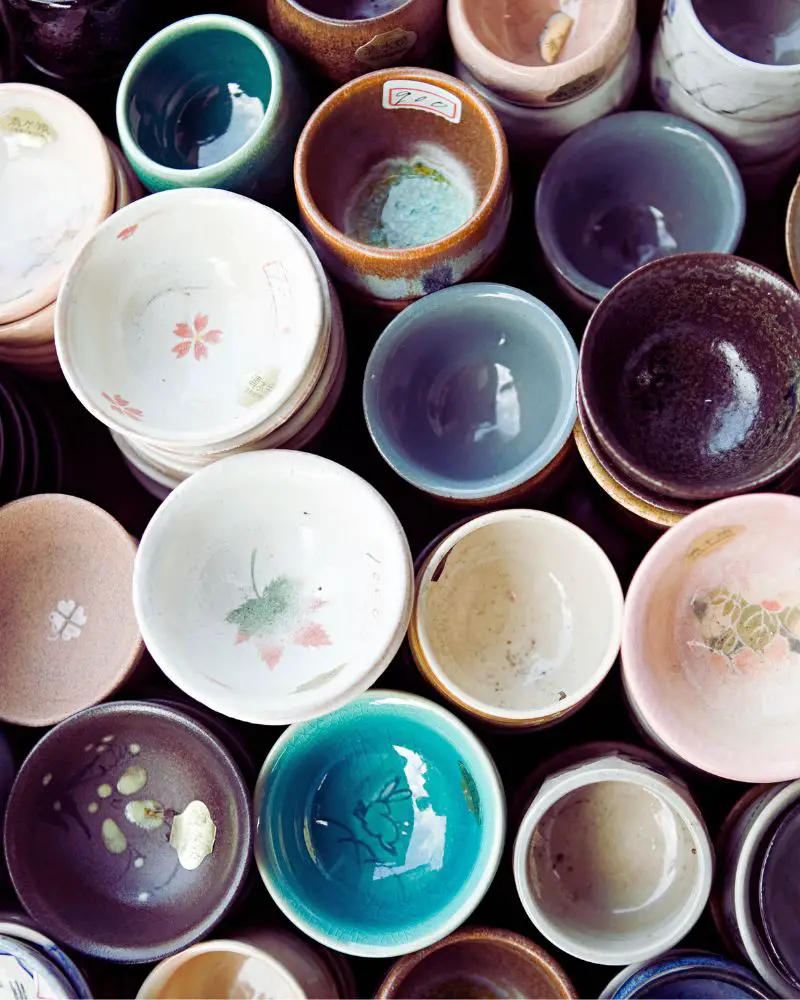
Speaking of selling your work…
There’s a growing demand for unique, handmade goods like pottery. People want something that’s unique, is sustainable, and supports local or small business.
I’m happy to say that there are many people out there (are you one of them?) promoting quality over quantity. People are becoming more interested in slowing down and appreciating craftmanship than ever before.
These factors make selling pottery a unique opportunity for entrepreneurs. If you love making pottery, but also need a little side hustle, you could easily sell your handmade crafts.
You can find out how to turn your hobby into a side hustle by reading this: How to Turn a Hobby Into a Side Hustle.
More Great Posts About Pottery
I’ve created a library of posts dedicated to the craft of pottery making. Here are some other reads you may find interesting:
Cool Pottery Ideas for Beginner to Advanced Potters
How to Tell if Pottery is Valuable: A Beginner Guide
Is Pottery Microwave Safe? 5 Easy Ways to Check
7 Vital Pottery Studio Supplies, Equipment, and Tools
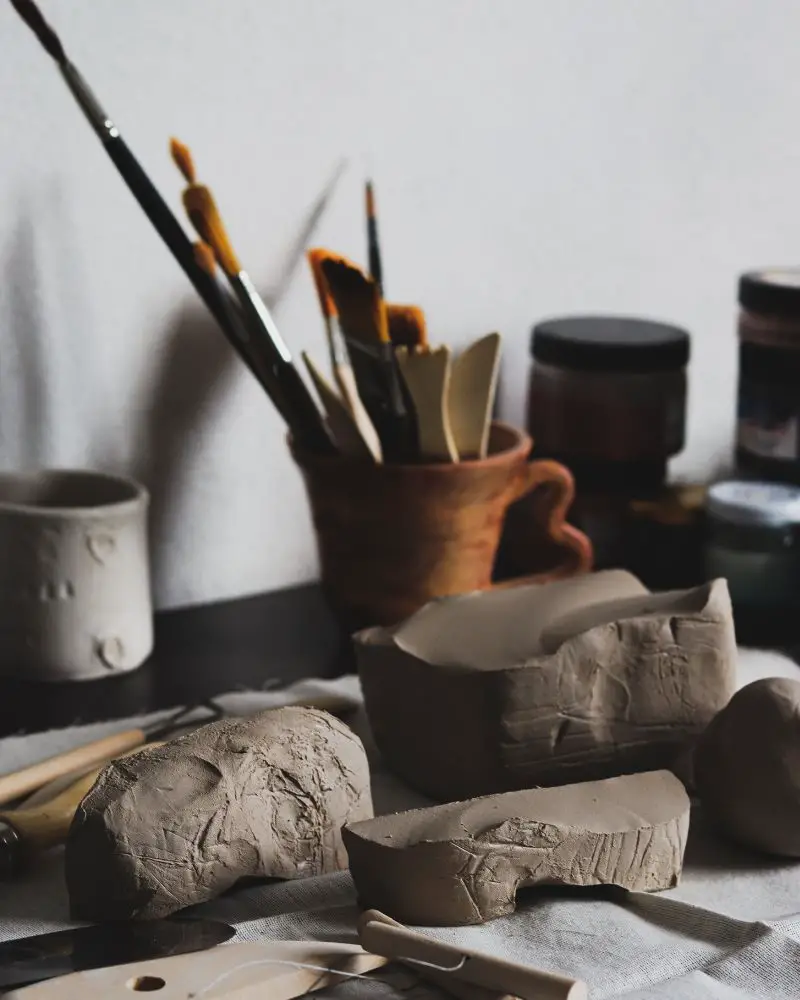
I’ve put together this list of important pottery studio supplies to get you started. Although I’ve listed Amazon as the place to pick up some of the supplies, you can look for less expensive alternatives by second-hand.
Kilns or pottery wheels, for example, might be available on websites like Craigslist, Facebook Marketplace, or in local, classified ads.
I am an Amazon affiliate (my side hustle) and I earn a small commission on qualifying purchases.
1. Clay and Materials
Clay is one of many important pottery studio supplies. They clay you use will depend on your specific needs, goals, and type of pottery you plan to create.
There are, however, a variety of versatile clay types commonly recommended. These include:
Stoneware Clay
Stoneware clay is best for general-purpose pottery. It’s often used for functional pieces and is good for hand-building or wheel-throwing.
Popular options include the Laguna B-Mix (smooth and easy to work with) and standard ceramic stoneware clay for it’s balance of plasticity and durability.
Be sure to include essential dry materials like terra sigillata for surface decoration, as well as pottery glazes—from clear glazes to dry glazes for your pieces.
2. Pottery Wheels
Whether you prefer wheel throwing or hand building, investing in a potter’s wheel is essential.
An electric kiln is a great option for efficiently firing your creations, while wheel accessories such as bats and tools enhance your throwing experience.
A wheel throwing setup helps you create pieces with ease, but don’t forget essential pottery tools like metal ribs and the wire clay cutter to refine your work.
3. Kiln and Ventilation
A kiln is a must-have for firing your pottery. Generally, there are three types of kilns to consider:
- electric kilns
- gas kilns
- wood-fired kilns
Most people looking for home pottery studio supplies tend to go with electric kilns. This is because they are relatively easy to operate, are more affordable, and are convenient for firing pottery in small quantities.
While electric kilns are safer in terms of emissions (compared to gas or wood-fired kilns), you should still ensure that you’re using it in a well-ventilated area.
For more information, read Kiln Safety Tips.
4. Worktables and Shelving
Set up your workspace with sturdy work tables for hand building, glazing, and sculpting.
For easy organization of studio essential supplies and finished pieces, invest in ware carts and efficient shelving. Ware carts aren’t strictly necessary, but they can be very helpful if you need to move pieces around the studio.
When working with soft clay or clay areas, you’ll want a table that can handle heavy use.
5. Essential Tools
Equip your studio with a variety of pottery tools like the needle tool for intricate details, metal ribs for shaping, slab rollers for even clay slabs, and pug mills for reclaiming and preparing clay.
If you’re just starting out, look for convenient studio starter packages like the ones created by Sculpd.
6. Safety and Cleaning Supplies
Keep your studio clean and safe with ceramic supplies designed for safety. Use dust masks and a wet/dry vacuum for managing dust, and invest in a utility sink with a clay trap to keep things clean.
7. Lighting and Utilities
Proper lighting is crucial for all pottery work, especially when using detailed pottery tools and pottery glazes.
Invest in bright, even lighting to enhance your studio essential workspace and make sure you have enough power outlets. You’ll need to accommodate your potter’s wheel, ball mills, and kiln.
By gathering these pottery supplies and studio equipment, you’ll set up a functional and organized pottery studio where you can explore hand building and wheel throwing techniques, create beautiful clay bodies, and refine your skills as a ceramic artist.
Summary List of Pottery Studio Supplies
To sum it all up, the following is a list of pottery studio supplies to help get you started:
- Clay (stoneware, earthenware, or porcelain)
- Potter’s Wheel (electric or kick wheel)
- Kiln (electric or manual, depending on space and budget)
- Clay Tools:
- Wire Clay Cutter
- Needle Tool
- Metal Ribs
- Sponges
- Loop Tools
- Sculpting Tools
- Brushes
- Work Surface (a sturdy table or workbench)
- Glazes (basic glazes like clear, white, or black)
- Glazing Tools (small brushes, sponges, or spray bottles)
- Studio Furniture:
- Shelving for drying and storage
- Ware Carts for moving pieces
- Safety Gear:
- Dust Mask (to protect from dust and fumes)
- Gloves (for handling glazes and clay)
- Plastic Sheeting or Damp Box (to keep clay moist during projects)
- Pug Mill (optional, for mixing and reclaiming clay)
- Drying Racks (for pieces to air dry)
- Electric Fan or Ventilation System (for kiln ventilation, if needed)
This list covers the basics to help you get started in pottery, but you can always expand as you gain experience and develop your style!
Get a Printable Pottery Studio Checklist
Why make things hard for yourself? Sign up for my newsletter and get a free, printable pottery studio checklist.
It’s easy to have on hand whether you’re shopping online or visiting shops. The pdf can easily be saved on your device or printed. Just complete the short form below and click on Download Your Checklist.
Summary
Ultimately, the type and quantity of pottery studio supplies you need will depend on your goals.
To get started, invest in a good kiln, pottery wheel, and a variety of clay types. You’ll also need some basic tools like the ones mentioned above.
You’ll need a needle tool, wire clay cutter, and metal ribs to get started. Of course, you’ll also need a studry worktable or workbench for hand-building and glazing.
With the right supplies, your studio can become the perfect place to craft, create, and explore the art of pottery.

